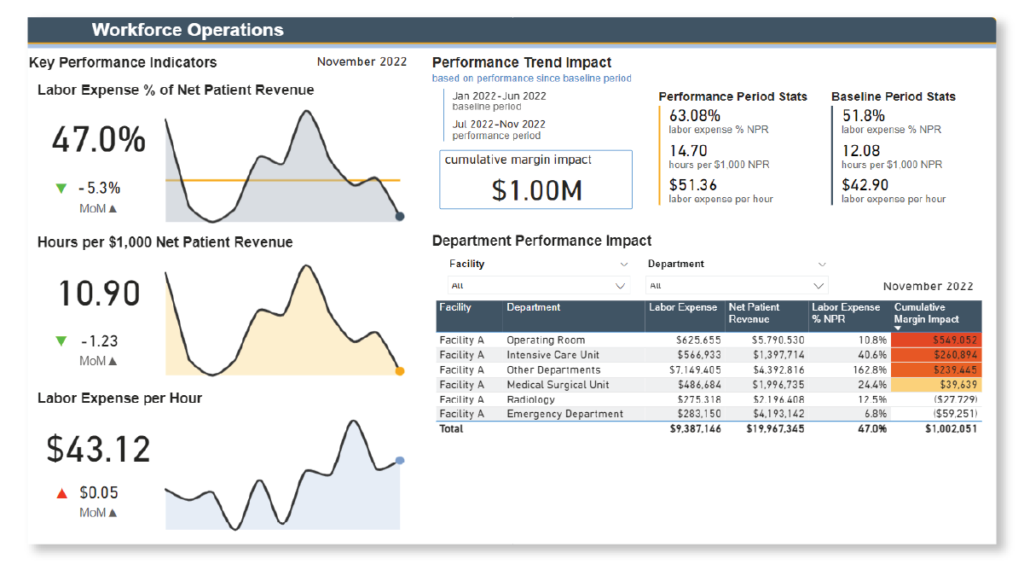For the last several decades, workforce management in healthcare has been synonymous with productivity, focusing on departmental efficiency and emphasizing peer comparisons to uncover opportunities to reduce staffing. And while a clear picture of patient demand and staffing alignment is a critical aspect of managing expense, there are now, more than ever, compelling reasons to expand the scope of workforce management.
Rethinking the Approach
Productivity, measured in worked hours per unit of service, is an important and generally manageable factor in the network of variables that ultimately drive labor expense margin – that is, the amount of revenue after labor costs to pay for supplies, overhead, other expenses, and, ideally, profit.
For many organizations, though, translating productivity into the ultimate workforce performance indicator remains a significant challenge mostly due to the way the healthcare industry has crafted its tools and analytics over the last 30 years. With all the market pressures now facing hospitals and health systems from staff turnover to reimbursement, it is time to expand our view of operations to include all the variables influencing the ultimate goal – labor expense as a percentage of net patient revenue.

Measuring Departmental Performance
Workforce productivity remains an important step to improving margin management. To learn more about Ovation Healthcare’s approach to workforce productivity, read the blog, Improving Healthcare Workforce Productivity, Without Cutting Staff. Still, there are some departments that lend themselves more easily to a “worked hours per unit of service” system than others.
Not All Departments are Created Equal
Certain departments like the emergency department or radiology have a clear unit of service by which to measure their performance and the scale necessary to allow for staffing adjustments, lending themselves well to a productivity measurement system (although there will likely still be a need to supplement this information with additional data to drive improvement).
Other departments like respiratory therapy or EKG have a clear unit of service but tend to operate at or near minimum staffing thresholds, especially in smaller organizations. While it is possible to measure these departments’ efficiency, it may be sufficient to simply ensure they’re following their minimum staffing plans.
Still, other departments like human resources or finance have no clear unit of output and tend to be square pegs forced into round holes when it comes to productivity systems. Typically, these departments are measured by approximating their workload using volume indicators like total facility employees or adjusted discharges which, regardless of results, tends to create more questions than answers for leaders attempting to use this information to drive action. Rather than attempting to force precision on these types of measurements, it is important to supplement them with additional measurements, such as:
- What percentage of total labor expense is comprised by support departments?
- Where are labor costs for support services going up or down disproportionately?
- Which support services drive the most significant cost and what alternatives may exist?
Ovation Healthcare Margin Management Tools
In addition to Ovation Healthcare’s Vantage Workforce Productivity platform, we are developing a robust dashboard system to allow hospitals and health systems to better explore their data. The purpose of these tools is to integrate productivity performance into the larger context of labor expense relative to net patient revenue and to allow leaders to explore departmental performance in the most meaningful context for each individual department.

The emergency department component of this dashboard system, for instance, will focus on labor expense per visit and guide users logically through the factors that influence it with industry standards, benchmarks, and internal goals layered into the visualizations. Exploration of the interactive dashboard might follow a path similar to the scenario outlined below.
Sample data exploration path:
- Labor expense per visit is trending upward compared to previous periods and exceeds budget. What is driving this?
- Worked hours per visit is increasing along with average hourly rate. What is driving this?
- Patient arrival patterns are shifting with more patients arriving later in the afternoon than what was seen in previous periods. Additional overtime is required to cover the new patient demand profile. What are arrival patterns forecasted to be in the next period?
Output:
- Optimized staffing plan to align staff with patient demand, alleviate staff stress, promote patient flow, and reduce labor expense per visit.
Additional data exploration components:
- Patient acuity
- Length of stay by provider, discharge disposition, diagnosis, and more
- Premium pay usage, including overtime, agency, and bonus pay
- Optional ancillary turnaround times








